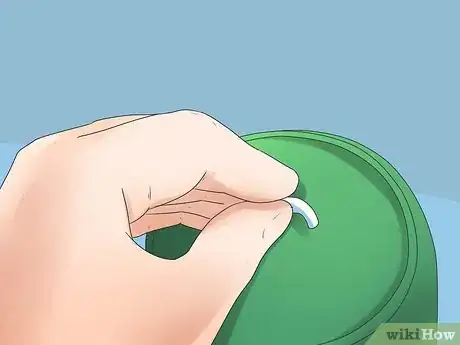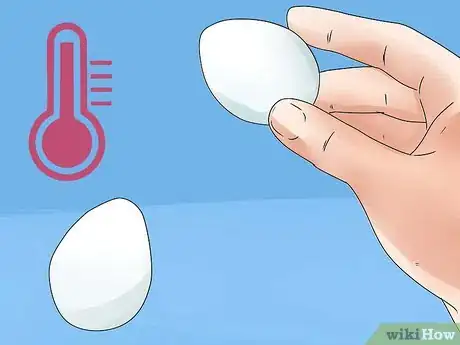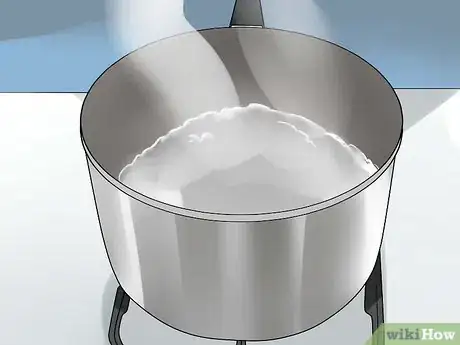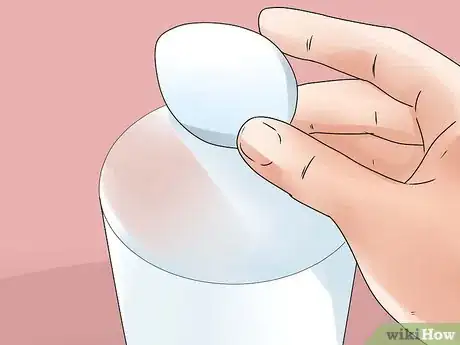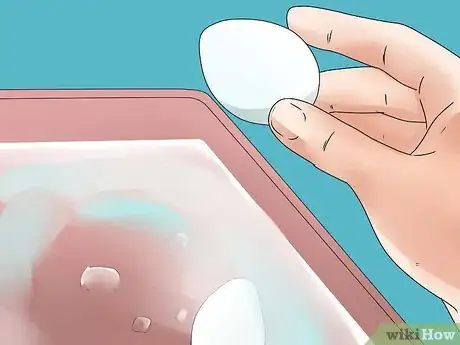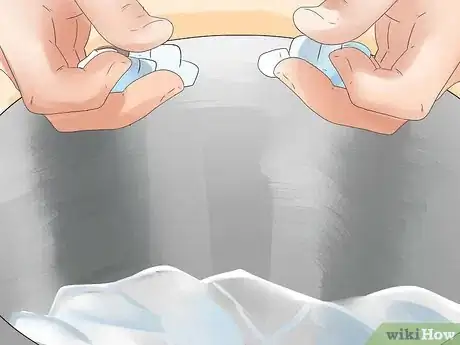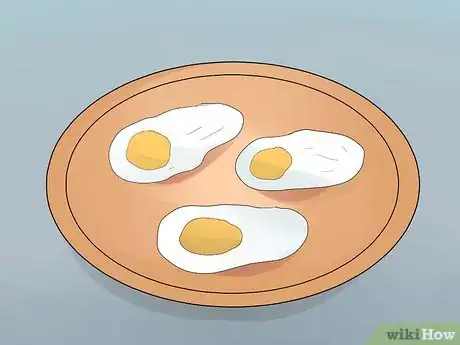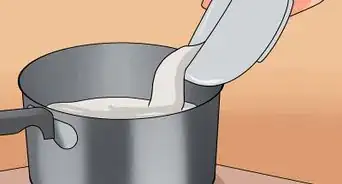X
wikiHow is a “wiki,” similar to Wikipedia, which means that many of our articles are co-written by multiple authors. To create this article, volunteer authors worked to edit and improve it over time.
This article has been viewed 91,112 times.
Learn more...
A coddled egg is simply a gently cooked egg with a runny to semi-runny consistency. If you plan on eating coddled eggs for breakfast, consider investing in an actual porcelain egg coddler. If you only need to coddle an egg for use in a recipe, though, you can prepare the egg without the actual coddler.
Ingredients
Makes 1 serving
- 1 to 2 eggs
- Water
- Butter, olive oil, or nonstick cooking spray
- Salt, to taste
- Black pepper, to taste
Steps
Method 1
Method 1 of 3:
Method One: Using an Egg Coddler
-
1Bring the eggs to room temperature. Remove the eggs from the refrigerator and let them sit out on your counter for about 30 minutes, or until they drop to room temperature.
- The cooking times will change if you use cold eggs, and you will have no way of knowing whether or not the eggs have coddled correctly until you crack one open. As a general rule, though, add another 1 to 2 minutes of cooking time if using cold eggs instead of room temperature eggs.
-
2Boil a pot of water. Fill a wide saucepan with 1 to 2 inches (2.5 to 5 cm) of water. Set the saucepan on the stove and heat on medium-high until the water begins to boil.
- You'll only want to use a little water. When you place the coddler inside, the water level should not reach above the halfway point of the coddler body. Do not fully submerge the coddler in water.
- To prevent the egg coddler from sliding around, line the bottom of the saucepan with a kitchen towel.[1]
Advertisement -
3Grease the egg coddler. Coat the inside of the egg coddler with nonstick cooking spray, butter, or cooking oil. Grease the inside of the metal lid, as well.
- Complete this step simultaneously with the previous step. In other words, you should prepare the egg coddler and the egg while the water is still working up to a boil, not after the water has already reached a boil.
- Use clean fingers or a clean paper towel to spread the grease on all inner sides of the coddler. The sides need to be well greased, but you should not have enough excess to form a puddle at the bottom of the coddler.
-
4Break the egg into the coddler. Both the white and yolk of the egg should be broken directly into the coddler. Add any salt and pepper you want to the raw egg, as well.
- The number of eggs you should use will depend on the size of your coddler. Small egg coddlers only fit one egg, while large egg coddlers can fit two eggs.
- You can add other ingredients and seasonings, as well. Consider sprinkling in a look grated cheese, fresh herbs, crumbled bacon, or 1/2 tsp (2.5 ml) heavy cream.
-
5Screw the lid on. Loosely turn the lid on top of the egg coddler to secure it in place.
- The lid needs to be tight enough to prevent water or steam from seeping into the inner coddler, but it does not need to be extremely tight. A loose turn is usually enough.
-
6Place the egg coddler in the boiling water. Carefully lower the egg coddler into the boiling water. Allow the egg to cook for 5 to 8-1/2 minutes.[2]
- The exact cooking time will vary depending on the size of your coddler and the size of your eggs.
- For one medium egg in a small coddler, cook it for 5 minutes.
- For one large egg in a small coddler, cook it for 5 and 1/2 minutes.
- For two medium eggs in a large coddler, cook the eggs for 6 and 1/2 minutes.
- For two large eggs in a large coddler, cook the eggs for 8 and 1/2 minutes.
- The exact cooking time will vary depending on the size of your coddler and the size of your eggs.
-
7Open the coddler. Carefully remove the egg coddler from the hot water and place it on a heat-resistant surface, like a kitchen towel. Grab the side of the metal lid with an oven mitt or separate towel and twist it off.
- Insert the end of a spoon or fork into the ring on top of the metal lid and lift the coddler out that way. Alternatively, lift it out by grabbing it with oven mitts.
-
8Serve the egg. The egg should be enjoyed immediately and served while still inside the coddler.
Advertisement
Method 2
Method 2 of 3:
Method Two: Without an Egg Coddler
-
1Use room temperature eggs. Remove the eggs from the refrigerator about 30 minutes before the process begins. Allow them to sit out on your kitchen counter or table until they drop to room temperature.
- Cold eggs will take longer to cook and may not coddle evenly. As a general rule, though, you should coddle cold eggs for 30 to 60 seconds longer than room temperature eggs.
-
2Prepare boiling water. Fill a small tea kettle with water and set it on the stove over high heat. Continue heating the water until the kettle whistles and the water is boiling.
- You could also prepare the water in a small saucepan if you do not have a kettle.
-
3Prepare an ice bath. As the water in your kettle reaches a boil, prepare an ice bath by filling a medium bowl halfway with cold water and a handful or two of ice.
-
4Place the eggs in a mug or bowl. Place each egg in a separate heat-resistant container, and place each container on a heat-resistant surface, like a kitchen towel.
- You can place multiple eggs in the same bowl, but you do not want the eggs to touch each other at all. If the eggs are packed together inside a dish, the coddling process may not be able to cook the entire egg evenly.
-
5Pour boiling water onto the eggs. Once the water has reached a boil, pour it directly over the eggs. Allow the eggs to sit in the hot water for a full 1 minute.[3]
- This amount of time will produce a coddled egg that is still quite runny. If you want the egg white to firm up a bit, you should leave the eggs in the hot water for about 5 minutes each.
- Alternatively, if you prepared the hot water in a saucepan, you could remove the saucepan from the heat and dip the egg directly inside the simmering water. Keep it there for 1 minute.[4] Coddling the egg this way may make the eggshell more likely to break, however.
-
6Cool the eggs in the ice bath. Carefully remove the eggs from the hot water with a slotted spoon or tongs, then gently dunk them into the ice bath. Let them stay in the ice bath for 2 minutes to stop the cooking process.
- Work carefully to prevent the eggshell from cracking. The eggs are still very runny at this point, so cracking the shell will cause the egg to spill out in a watery mess.
-
7Use the coddled egg as desired. To get to the eggs, simply crack the shells and dump the contents into a small dish.
- Coddled eggs prepared in this manner are most often used in recipes that call for coddled eggs as an ingredient, like Caesar salad dressing and mayonnaise. They are rarely consumed as they are, but you could technically do so. Either way, you should use the coddled egg immediately.
Advertisement
Method 3
Method 3 of 3:
Method Three: Microwave Coddled Eggs
-
1Prepare a shallow ice bath. Fill a shallow bowl or dish with no more than 1 inch (2.5 cm) of cold water. Add a little ice to drop the temperature even further.
- You'll be dropping an open container into this ice bath, so the water needs to be shallow. Otherwise, the water could seep into the cooked egg when you place the container inside the ice bath later on.
-
2Break the egg into a small bowl. Crack the egg or eggs directly into a small, microwave-safe glass bowl.
- You do not nee to cover the dish during this step.
- Use a bowl with sides that are at least 3 inches (7.6 cm) tall to prevent ice water from getting inside later on.
-
3Microwave the egg for 10 to 15 seconds. Heat the egg in the microwave on full power. For one egg, only microwave it for 10 seconds. For two eggs, microwave them for 15 seconds.
- When done, the eggs should be slightly cooked yet still have a very runny consistency.
-
4Cool the egg. Carefully place the bowl containing the eggs inside your ice bath. Let it sit there for 30 to 60 seconds to stop the cooking process.
- Consider placing a lid or a sheet of plastic wrap over the bowl to help prevent ice water from accidentally seeping inside.
-
5Use as needed. Coddled eggs prepared in this manner are usually used for dressings and other recipes calling for coddled eggs rather than being eaten plain.
Advertisement
Things You'll Need
Using an Egg Coddler
- Egg coddler
- Paper towel
- Kitchen towel(s)
- Saucepan
- Fork or spoon
- Oven mitts
Without an Egg Coddler
- Tea kettle OR small saucepan
- Heat-resistant mugs
- Medium bowl
- Slotted spoon
Microwaved Coddled Eggs
- Shallow bowl or dish
- Microwave-safe glass bowl
- Oven mitts
References
About This Article
Advertisement




